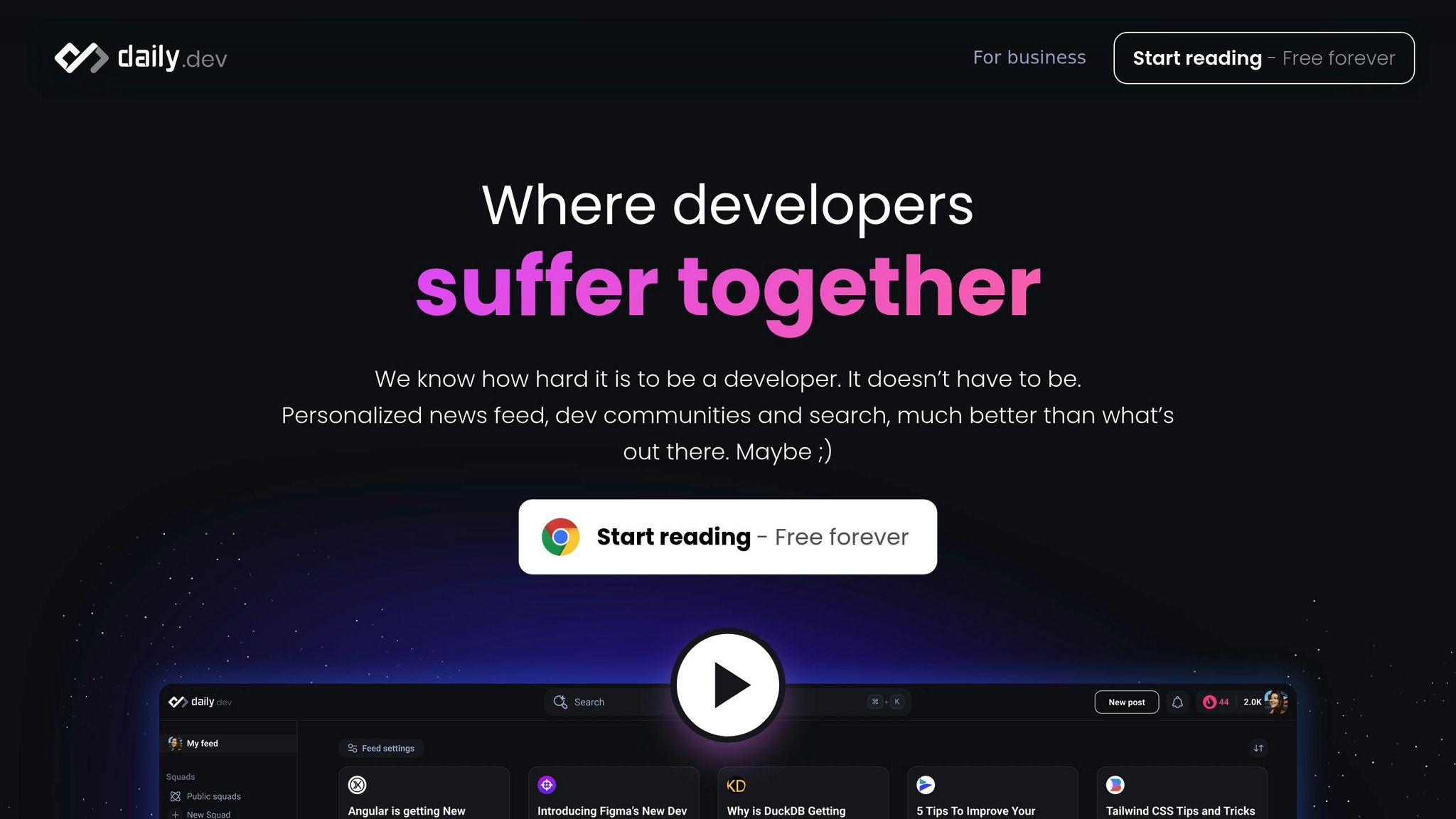


Engage developers effectively by focusing on technical accuracy, community involvement, and clear communication for lasting trust and value.
Developers are a unique audience. They value facts over fluff, demand technical accuracy, and prioritize proof of value over promises. To win them over, your marketing must focus on trust, transparency, and practical solutions. This article outlines seven strategies to effectively engage developers:
- Technical Documentation: High-quality, detailed documentation builds trust and serves as a long-term marketing asset. Include code examples, troubleshooting guides, and integration tips.
- Community Engagement: Participate in developer communities, contribute to open-source projects, and sponsor events to build credibility.
- Targeted Ads (e.g., daily.dev Ads): Use developer-specific platforms for precise targeting and seamless ad integration.
- Workshops and Training: Offer hands-on learning opportunities to educate developers while subtly showcasing your product.
- Developer Advocacy: Hire technical advocates to bridge the gap between your company and the developer community.
- Clear Messaging: Use precise, technical language to communicate your product's value and address developer pain points.
- Engagement Metrics: Track developer-specific analytics like API usage, documentation engagement, and integration success rates to refine your strategy.
Key takeaway: Developers respond to honesty, practical value, and meaningful engagement. Skip the buzzwords - focus on solving their problems and earning their trust.
Developer Marketing: How to Resonate with Developers by Understanding Their Buying Habits
1. Content-First Marketing Through Technical Documentation
For developers, technical documentation isn't just a resource - it's the ultimate marketing tool. Unlike other audiences who might respond to flashy campaigns, developers judge a product by the quality, clarity, and depth of its documentation. Well-written technical content doesn’t just educate; it establishes credibility and lays the groundwork for lasting trust. This kind of approach creates opportunities for interactive features that genuinely engage developers.
Why Technical Documentation Works for Developers
Technical documentation resonates because it speaks directly to developers in their own language. When encountering a new tool or service, developers instinctively turn to the documentation. They want details: how it works, what problems it addresses, and how it fits into their existing workflows.
Including code examples and interactive API testing lets developers see the product in action immediately. Features like in-browser API testing take this a step further, allowing hands-on exploration without extra setup.
Developers also value troubleshooting guides and sections on common pitfalls. These elements show that you’ve thought beyond ideal scenarios and understand the challenges developers might face. Acknowledging potential issues while providing solutions demonstrates a mature and well-rounded approach to the developer experience.
Building Trust Through Documentation
The quality of your documentation directly impacts how much developers trust your product. Regularly updated content with version-specific examples reassures users that the product is actively maintained.
Being upfront about limitations, known issues, and system requirements builds credibility. Developers prefer honesty over discovering constraints mid-project. Documentation that transparently outlines what the product can and cannot do often earns more trust than overly polished marketing claims.
Accuracy is critical. A single incorrect code snippet can undermine confidence in your product. Many successful companies ensure developer reviews of all technical content to avoid errors and maintain trust.
Delivering Practical Value
The best technical documentation doesn’t stop at basic instructions - it provides real value. Detailed integration guides that show how to connect your product with popular tools save developers time and effort. Sections on performance tips and best practices transform your documentation into a go-to resource.
Including real-world examples is another way to add value. Developers appreciate documentation that covers authentication, error handling, and production concerns in one place. Migration guides with side-by-side code comparisons or even automated tools can make adoption significantly easier, encouraging developers to seriously consider your solution.
Long-Term Benefits of Strong Documentation
Quality documentation isn’t just useful - it’s a long-term marketing asset. Unlike paid ads that stop working the moment you stop funding them, great documentation continues to drive value. Search engines favor detailed, useful content, often making your documentation the first point of contact for new developers.
Good documentation also fosters community contributions. Developers who find your content helpful often contribute by adding examples, fixing errors, or even translating sections. This collaborative effort not only improves the documentation but also creates invested advocates for your product.
Using a modular documentation structure makes it easier to update and expand content as your product evolves. By organizing documentation into reusable components and maintaining clear versioning, you can keep pace with changes without overhauling everything.
To make documentation a sustainable marketing channel, treat it like a core product. Dedicate resources, track engagement metrics, and iterate based on developer feedback. Companies that prioritize documentation often find it becomes one of their most cost-effective and impactful marketing efforts over time.
2. Community-Driven Engagement and Open Source Contributions
Developers do more than just write code - they create and nurture communities. Community-driven engagement builds genuine, two-way connections that earn respect through action. This approach turns marketing into something developers actually welcome and value, rather than avoid.
Effectiveness in Engaging Technical Audiences
Developer communities thrive on meritocracy and transparency. They don’t judge companies by flashy campaigns or massive budgets. Instead, they focus on the quality of contributions and authentic engagement. Companies that sponsor hackathons, contribute to open source projects, or host technical meetups offer meaningful ways for developers to interact with their expertise.
Take GitHub sponsorships, for example. By supporting projects that developers depend on, companies can gain visibility and goodwill within the developer ecosystem.
Another effective channel is developer conferences and meetups. Sending engineers - not just marketing teams - to speak at these events shows real technical depth. Developers want to hear from peers who understand their challenges and can share practical, hands-on insights. These events become a natural bridge between showcasing expertise and fostering community connections.
Building Trust and Credibility
In the developer world, open source contributions are a gold standard for credibility. When companies release helpful tools or improve existing projects, they prove their technical chops. Developers can dig into the code, examine commit histories, and see firsthand if a company truly knows its stuff.
Active participation on platforms like Stack Overflow, Reddit, or Discord also goes a long way. Companies that consistently provide thoughtful answers, share useful insights, and engage in meaningful discussions build reputations as trustworthy community members. This reputation directly influences how developers perceive their products.
Transparency in development practices further strengthens this trust. Companies that openly share their engineering challenges, explain their technology choices, or admit to mistakes earn respect. This kind of honesty resonates deeply with developers, who face similar struggles in their own work and value authenticity over polished marketing.
Offering Practical Value to Developers
The best community engagement strategies focus on solving real-world developer problems. Companies that create and maintain essential tools provide immediate, tangible value. Over time, these tools often become vital parts of developers’ workflows, creating positive associations with the company behind them.
Community channels are also great for sharing educational content. Hosting workshops, publishing tutorial series, or maintaining repositories of learning resources helps developers expand their skills. This positions the company as a partner in their success, rather than just another vendor vying for attention.
Developer advocacy programs play a unique role here. By hiring developers who understand both community needs and company goals, these programs create a bridge between the two. Advocates can identify what the community really needs, deliver meaningful solutions, and communicate in a way that feels authentic to other developers. This dual perspective makes them invaluable.
Long-Term Benefits of Community Engagement
Investing in community initiatives pays off in the long run. Early contributions to open source projects or developer events often grow into self-sustaining ecosystems. Popular open source tools, for instance, can attract thousands of users and contributors, creating ongoing visibility with minimal additional effort.
A strong community presence also fuels organic word-of-mouth promotion. Developers trust recommendations from peers far more than traditional ads, and a good reputation spreads naturally within these circles.
There’s another bonus: hiring top talent. Companies known for their contributions to the developer community and open source work often find it easier to attract skilled developers who want to work with like-minded people.
However, this kind of engagement isn’t a one-time effort. It requires consistent, long-term commitment. Companies that stay involved in the community, regularly contribute to open source projects, and support developer-focused events build relationships that last. Over time, this approach transforms marketing from a cost into an investment that grows in value year after year.
3. daily.dev Ads: A Developer-Focused Advertising Platform

Engaging with a community builds meaningful, long-term relationships, but sometimes you need direct access to your audience. That’s where daily.dev Ads steps in - offering targeted campaigns designed specifically for developers. It complements earlier community-driven efforts by delivering measurable, immediate engagement.
Effectiveness in Engaging Technical Audiences
With daily.dev Ads, you can reach over 1 million developers worldwide through native ad placements that naturally integrate into their daily workflow. The platform allows precise targeting based on factors like seniority, programming languages, and tools, ensuring your ads connect with the right people.
What makes this approach stand out is its seamless integration. Ads appear in developers' in-feed content, post pages, and personalized digests, blending into the information they’re already consuming. This design makes the ads feel like part of the content rather than interruptions, giving you the space to deliver detailed messages that resonate with a technical audience.
Building Trust and Credibility
daily.dev Ads leverages its reputation as a trusted platform for developers. By operating in a secure and developer-friendly environment, it ensures that your technical messages are not only seen but also taken seriously.
The platform also provides creative guidance to help optimize campaigns, ensuring your ads communicate technical value effectively. Plus, with real-time performance tracking, you can monitor how your campaign is doing and identify which segments of the developer audience are responding best.
Practical Value for Developers
This platform shines when it comes to promoting tools, events, or resources that developers can immediately use. Whether you’re launching a new API, organizing a technical conference, or offering helpful resources, daily.dev Ads ensures your message reaches the right people.
Its advanced targeting tools allow you to focus on specific niches. For example, if you’re promoting a Python framework, you can exclusively target Python developers. Hosting an event in San Francisco? You can zero in on developers in that area. This precision eliminates wasted impressions and ensures your ad budget is spent wisely. And with prime ad placements, your message grabs attention without disrupting the user experience.
Scalability for Long-Term Marketing Efforts
daily.dev Ads makes it easy to scale your campaigns from local to global audiences - all without needing to switch platforms. Whether you’re a startup aiming to reach your first 1,000 developer users or an established company launching a product worldwide, daily.dev Ads adapts to your needs.
The platform’s flexibility allows businesses to refine their campaigns based on performance data, helping you maximize your return on ad spend. By combining precise targeting with scalable reach, daily.dev Ads not only supports your current goals but also strengthens your overall developer engagement strategy.
4. Educational Content Marketing Through Workshops and Training
Workshops and training provide developers with hands-on learning opportunities that go beyond traditional advertising. This approach positions your company as a trusted source of knowledge rather than just another vendor trying to push a product.
Why Workshops Work for Developers
Workshops and training sessions resonate with developers because they address genuine learning needs. Developers are always looking to stay current with new technologies, frameworks, and best practices. By offering meaningful educational experiences, you naturally capture their attention.
The most effective workshops strike a balance - spending about 80% of the time on education and 20% on subtly integrating your product. This way, developers leave with actionable skills they can apply immediately, while also gaining exposure to your solutions.
Incorporating live coding, interactive Q&A sessions, and hands-on exercises keeps participants engaged. These elements not only make the sessions more dynamic but also reinforce your technical credibility.
Building Trust and Reputation
Educational content marketing helps establish your company as a respected voice in the developer community. By consistently offering high-quality learning opportunities, you build trust over time. This trust is further strengthened through other efforts like detailed documentation and active community support.
Workshops also create a ripple effect. Developers who attend your sessions often share their positive experiences with colleagues, sparking organic word-of-mouth recommendations. In technical circles, this kind of peer endorsement carries a lot of weight.
Practical Benefits for Developers
Workshops that teach practical skills - like mastering a programming language, debugging techniques, or architectural design - deliver immediate value. Developers gain knowledge they can directly apply to their work, making your sessions worthwhile.
Offering certification programs adds even more value. When developers earn credentials through your training, it not only enhances their resumes but also strengthens their connection to your brand. It’s a win-win: they grow professionally, and you build stronger relationships with potential customers.
To maximize the impact, record your sessions and provide downloadable materials like code samples, slides, and additional resources. Developers appreciate having these references to revisit as they implement what they’ve learned.
Scaling for Broader Impact
Educational content, like workshops, can scale effectively over time. Start small with local events, then expand to virtual workshops to reach a global audience. Online sessions remove geographical barriers, allowing you to connect with developers worldwide.
Standardizing workshop modules ensures consistency and quality, no matter who delivers the training or where it’s held. This approach also makes it easier to train your internal team to take on facilitation roles.
Collaborating with partners like coding bootcamps, universities, or tech meetups can help you scale even faster. These partnerships give you access to ready-made audiences and venues, creating recurring opportunities to engage with developers and strengthen your presence in the community.
Finally, repurpose your workshop materials into other content formats - like blog posts, video tutorials, or documentation. This extends the life and reach of your efforts, complementing your broader marketing strategy and keeping your brand top of mind for developers.
sbb-itb-e54ba74
5. Technical Advocacy and Developer Relations Programs
Technical advocacy and developer relations programs focus on building genuine connections with developer communities by combining technical know-how with hands-on experience. This approach adds a personal, relatable element to traditional community engagement efforts.
Developer advocates act as intermediaries between companies and developer communities. They bring a unique perspective, understanding both the technical hurdles developers face and the business objectives companies aim to meet. This dual insight makes them especially effective in connecting with technical audiences.
Engaging with Technical Audiences
Developer advocates excel at connecting with technical audiences by addressing real-world challenges and speaking in terms developers understand. They actively participate in technical discussions, contribute to open-source projects, and share actionable insights that developers can immediately use.
Their focus is on education. Advocates create technical blogs, code samples, and forum responses that solve specific problems, earning credibility as trusted peers rather than coming across as sales representatives.
Another key strength lies in gathering community feedback and turning it into actionable insights for product teams. This two-way communication ensures companies stay aligned with the actual needs and concerns of their user base.
Advocates also maintain an active presence on platforms like GitHub, Stack Overflow, and Twitter. By engaging in discussions and offering technical support, they ensure companies remain visible and relevant in developer communities without being overbearing.
Building Trust and Credibility
Trust is earned when advocates demonstrate real technical expertise and a genuine commitment to the community. Developers can easily spot the difference between someone who understands their struggles and someone delivering a rehearsed pitch.
The most effective advocates have strong technical skills and continue to code, even in their advocacy roles. They can dive into complex technical discussions, debug problems alongside developers, and offer meaningful solutions.
Transparency is another pillar of trust. Advocates who openly discuss both the strengths and limitations of tools or products foster a sense of honesty. Acknowledging when a tool isn’t the right fit for a specific use case often strengthens their credibility.
Consistency over time is more impactful than flashy, short-term campaigns. Advocates who consistently provide value and support over months or years build lasting relationships. Developers remember those who helped them solve tough problems and contributed to their professional growth.
Delivering Practical Value to Developers
Developer relations programs offer tangible benefits through various channels. Advocates create content like detailed tutorials, architectural guidance, and best practices that directly address developers' challenges.
They also provide resources like sample repositories and starter templates, saving developers time and offering proven solutions they can adapt to their projects.
Beyond content, advocates help build connections within the developer community. They introduce developers to one another, facilitate collaborations, and create opportunities for networking. These efforts often benefit developers in ways that extend far beyond any single product or company.
Advocates also offer hands-on support that goes beyond traditional customer service. They provide architectural advice, conduct code reviews, and offer strategic guidance, helping developers succeed in their projects.
Long-Term Impact on Marketing Efforts
Developer relations programs deliver lasting benefits. Every helpful interaction and piece of valuable content contributes to a company’s reputation and reach over time.
Content created by advocates - such as blog posts, video tutorials, and code samples - remains useful long after its initial release. This type of evergreen content continues to generate value and reinforces a company’s commitment to the developer community.
Advocacy efforts also grow organically through community engagement. When advocates provide genuine value, developers naturally share their content, recommend their resources, and invite them to participate in events. This kind of organic growth often outperforms traditional advertising in terms of reach and impact.
Within companies, successful advocacy programs often create internal champions. By bringing developer feedback to product teams and influencing product direction, advocates demonstrate measurable business value. This internal support ensures the long-term sustainability and growth of these programs.
The relationships built through developer advocacy programs don’t just strengthen a company’s reputation - they create a competitive edge by positioning the company as a trusted partner in developers’ careers and projects.
6. Clear Technical Messaging and Value Communication
In addition to solid documentation and active community involvement, clear technical messaging plays a key role in connecting with developers. This type of messaging requires precision and meaningful content, steering clear of superficial buzzwords. Developers want to know exactly what a product does, how it operates, and why it’s relevant to their specific needs.
The most successful companies focus on concrete benefits like faster deployment, improved performance, and smoother integration.
Engaging Technical Audiences Effectively
Developers respond to messaging that acknowledges the complexity of their work and the challenges they face.
The best technical messaging speaks the same language developers use daily. Terms such as API endpoints, latency optimization, and scalability aren’t just jargon - they’re the essentials developers care about. When these terms are used correctly and in the right context, it signals expertise and credibility.
Examples rooted in real-world applications help simplify complex ideas. Developers prefer to evaluate tools by seeing how they work in practice, which allows them to determine if the solution aligns with their needs.
Visual aids like architecture diagrams, performance graphs, and workflow illustrations are incredibly helpful. These tools make it easier for developers to understand intricate concepts, such as system relationships or data flows, at a glance. This clarity not only speeds up the evaluation process but also builds trust.
Building Trust and Credibility
Trust in technical messaging is built on accuracy and transparency. Being upfront about what a product can and cannot do earns respect. For example, if a company specifies that its solution is ideal for certain scenarios or requires specific technical setups, developers appreciate the honesty and can make better-informed decisions.
The quality of technical documentation is another trust signal. Well-organized and detailed documentation shows that a company understands what developers need and is committed to supporting them. On the other hand, poor documentation can undermine confidence in both the product and the company behind it.
Consistency is key. Developers will test claims and compare them against the product's actual performance. If there’s a gap between promises and reality, trust can be quickly eroded - and once lost, it’s hard to regain.
Delivering Practical Value to Developers
Clear messaging doesn’t just build trust; it also helps developers make decisions faster. Messaging that outlines integration processes, performance metrics, and compatibility gives developers the information they need to assess a product efficiently.
Focusing on problems developers encounter resonates more than leading with features. Messaging that starts by addressing common pain points and then explains how the product solves them feels more relevant and actionable.
Sharing performance data and benchmarks adds another layer of value. Metrics like response times, throughput improvements, or resource efficiency allow developers to estimate how a product might impact their own systems, enabling data-driven decision-making.
Long-Term Scalability of Technical Messaging
Technical messaging frameworks are built to last because they focus on core principles rather than fleeting trends. Concepts like performance, reliability, and seamless integration remain relevant, even as products evolve and markets shift.
High-quality technical content has a lasting impact. It not only educates developers on best practices but also serves as a long-term resource that can be revisited over time. This makes it a valuable asset for ongoing marketing efforts.
A modular approach to messaging enhances flexibility. Core technical explanations can be adapted for various formats - whether it’s documentation, blog posts, conference talks, or sales materials - ensuring consistency while reducing the effort required to create new content.
Clear and accurate messaging also encourages organic growth within developer networks. When developers find genuine value in a product and its messaging, they’re more likely to share it with colleagues facing similar challenges. This type of peer-to-peer recommendation often carries more weight than traditional advertising.
7. Performance Metrics and Developer Engagement Analytics
When it comes to understanding how developers interact with tools and platforms, a tailored approach to analytics is essential. Developers typically assess products based on technical merits, and their engagement often reflects a deeper, more thoughtful decision-making process. This means the focus shifts from surface-level interactions to metrics that highlight the quality and depth of their engagement.
Effectiveness in Engaging Technical Audiences
Developer engagement metrics provide unique insights into how technical audiences interact with content and tools. For instance, tracking time spent on documentation, code example downloads, and API testing frequency offers a clearer picture of what resonates with developers compared to standard metrics like click-through rates.
GitHub activity is another strong indicator of genuine interest. Actions like forking repositories, submitting issues, or contributing to open-source projects show a deeper level of involvement with a technology.
Developers also consume technical content differently. They often bookmark resources they find valuable and share insights within specialized forums or communities. Platforms designed for developers can track unique behaviors, such as how often code snippets are copied, SDK downloads are completed, or integration tutorials are followed through to the end. These metrics not only quantify engagement but also highlight where developers face challenges, enabling teams to refine resources for better usability.
Ability to Build Trust and Credibility
Metrics go beyond measuring engagement - they also help build trust. Developers value transparency, so analytics that track response times, bug resolutions, and documentation updates can demonstrate a company's commitment to its audience.
The health of a community is another important factor. Metrics like forum activity, quality of responses from technical teams, and the balance between community-generated and company-created content can signal authentic engagement. Developers are quick to notice when companies provide meaningful, precise answers instead of generic marketing speak.
Performance benchmarks, such as uptime statistics and real-world performance data, also play a role in fostering trust. Developers expect honesty about limitations and appreciate straightforward comparisons with alternatives. Additionally, when companies contribute to the broader tech ecosystem - through conference talks, open-source involvement, or publishing research - it positively impacts how developers perceive and engage with the brand.
Practical Value for Developers
Analytics should provide actionable insights that directly improve the developer experience. For example, tracking which sections of documentation are most visited, where users struggle in tutorials, and which code examples are most implemented can guide improvements to technical content.
Metrics like integration success rates are particularly valuable. By analyzing how many developers complete integrations and identifying common implementation patterns, companies can pinpoint areas where resources or tools may need refinement.
Error tracking is another useful layer. Monitoring frequent error messages, how developers resolve issues, and which troubleshooting resources are most effective can lead to the creation of more helpful support materials.
Feedback loops are critical here. By analyzing internal search queries within documentation or identifying recurring themes in support tickets, teams can uncover content gaps and opportunities to better serve their developer audience.
Scalability for Long-Term Marketing Efforts
Developer engagement often unfolds over extended periods, so analytics frameworks need to support longer decision-making cycles. Developers may take weeks or even months to evaluate tools, making it important to track engagement over time.
Cohort analysis is particularly useful for understanding developer behavior. By observing how different groups progress from initial interest to active implementation, companies can identify what strategies work and where improvements are needed.
Scalable analytics also play a key role in tracking long-term engagement. When analytics are integrated with developer tools or version control systems, they provide a more comprehensive view of how marketing efforts influence product adoption.
These long-term insights can also help identify developer advocates - those who repeatedly engage with content, contribute to technical discussions, and influence adoption decisions within their organizations. Building relationships with these advocates can lead to stronger adoption rates and more impactful word-of-mouth marketing.
Over time, the benefits of meaningful developer engagement become clear. Developers who have positive experiences often turn into loyal contributors, customers, or even champions of the product, creating a ripple effect that extends beyond traditional marketing metrics.
Conclusion
Marketing to developers demands a departure from traditional advertising methods. As highlighted in this article, technical audiences respond best to genuine value, honest communication, and active community involvement, rather than flashy or superficial tactics.
The key to effective developer marketing lies in technical credibility and community trust. At its core, this means prioritizing content-driven strategies - things like detailed technical documentation and educational resources. Why? Because developers are problem-solvers who judge tools based on their technical merit, not on marketing fluff.
Equally important is community engagement. Developers place a high value on peer recommendations and contributions to open-source projects. Companies that actively participate in developer communities, contribute meaningful code, and engage in technical discussions build relationships that last far beyond a single purchase.
Platforms like daily.dev Ads make it easier to target developers by factors like seniority, programming language, and tools they use. This precision ensures your message reaches the right audience, leading to stronger engagement and more meaningful interactions.
Workshops, training sessions, and advocacy programs are also powerful tools for building credibility. When developers associate your brand with learning opportunities and professional growth, they’re more likely to consider your products when it’s time to make decisions.
Another crucial element is clear technical messaging. Developers appreciate straightforward communication about what a product can and cannot do. Marketing materials that include technical specifics - like performance benchmarks, feature limitations, and honest comparisons - help developers make informed decisions faster.
Finally, tracking developer-specific metrics like documentation engagement, API usage, and integration success rates offers insights that traditional marketing metrics often miss. These data points provide a more accurate understanding of how developers interact with your tools and where improvements are needed.
Winning over developers requires respect, value, and a genuine connection to their needs. They can quickly tell if a company truly understands their challenges or is just pushing a product. The best strategies focus on education, transparency, and long-term relationships - not just quick wins.
Take time to evaluate your efforts. Add technical depth, engage authentically with developer communities, and track the metrics that matter most. Using platforms tailored for developer engagement can also help ensure your message resonates with the right audience in the right way.
FAQs
How can companies keep their technical documentation valuable and relevant over time?
To ensure technical documentation remains useful and up-to-date, companies need to focus on regular updates. This keeps the content accurate and in step with changing technologies. Right from the beginning, documentation should be designed for easy maintenance, making it simple to revise and expand as needed.
Good documentation isn't just a support tool - it can also serve as an educational resource. It helps users solve problems on their own, builds trust with a technical audience, and establishes credibility. When treated as both a support system and a marketing tool, documentation can boost user engagement, attract potential customers, and strengthen a brand’s reputation over time.
How do developer advocates help companies connect with developer communities?
Developer advocates serve as the connection point between companies and developer communities, promoting open dialogue and building trust. They interact with developers through platforms like forums, events, and social media, collecting feedback that’s shared with internal teams.
This role ensures that developers’ voices influence product development, enabling companies to create tools and solutions that truly resonate with technical users. By nurturing these relationships, developer advocates help align company objectives with the expectations and needs of the developer community.
How do platforms like daily.dev Ads help effectively reach technical audiences?
Platforms like daily.dev Ads make it easier to connect with technical audiences by delivering highly targeted messages. These platforms use advanced algorithms and data insights to ensure your ads reach the right people at the right moment. The result? Increased engagement and a better return on investment (ROI).
This strategy works particularly well for technical audiences, who appreciate precision and relevance. By addressing their specific interests and priorities, you can establish trust, showcase your product's technical strengths, and build deeper connections with this specialized group.






